Contrary to what one would probably expect from a digital currency, Bitcoin is in certain aspects more similar to cash than to a bank account.
A Bitcoin wallet also bears its name because it does not combine received Bitcoins into a sum, as is the case with a bank account, but stores them as individual transactions, like a physical wallet storing individual notes.

When you receive a Bitcoin transaction, it's a bit like someone handing you a bank note. However, unlike cash, these bills do not have a fixed value (like 5, 10, 20€), but correspond to the exact amount of the transaction received. Such a "note" is called a "UTXO", which stands for "Unspent Transaction Output".
Anyone who has taken a closer look at their transactions in a blockchain explorer will have noticed that a transaction does not always consist of just one sender and one recipient.
The fact that there are multiple "senders" is because multiple UTXOs were used for that transaction. If you want to send 0.1 BTC to someone, but you only have two UTXOs each worth 0.07 BTC, you can use them together for one transaction.

But how can you send a 0.1 BTC transaction with two 0.07 BTC UTXOs if these "notes" always have to be spent in the exact amount of the transaction? Bitcoin wallets use a clever trick for this. Because a transaction can pay more than one person at a time, we specify two recipients: the recipient of the 0.1 BTC, as well as ourselves as the recipient of the "change" of 0.04 BTC.

Because it is very rare for a UTXO to be exactly equal to the amount of the transaction, virtually every transaction contains a so-called "change output". The change output is sent back to an address automatically generated by your own wallet.
This is also the reason why sometimes you have to wait after a transaction before you can send another one - you have to wait for the incoming change transaction to confirm.
Bitcoin wallets usually decide automatically which of your UTXOs are best for a particular transaction.

To decide yourself which UTXOs you want to use for your transaction, you can activate the "Coin Control" feature in the BitBoxApp. During the sending process you will then be able to choose one or more UTXOs.
Where are Bitcoin UTXOs stored?
Your UTXOs are associated with the addresses of your wallet. The UTXOs themselves are 'stored' in the Bitcoin blockchain.
What is the UTXO model?
The UTXO model means, that every transaction you receive in your wallet is a seperate "bill" you can use to spend on a transaction.
What are the differences between UTXOs vs account balances?
In contrast to Bitcoin, Ethereum for example, uses account balances instead of UTXOs. With account balances, you can easily tell how much coins a certain user holds. That's because instead of using a new address for every transaction, Ethereum just uses one account. Account- and UTXO models both have different benefits and disadvantages.
Don’t own a BitBox yet?
Keeping your crypto secure doesn't have to be hard. The BitBox02 hardware wallet stores the private keys for your cryptocurrencies offline. So you can manage your coins safely.
The BitBox02 also comes in Bitcoin-only version, featuring a radically focused firmware: less code means less attack surface, which further improves your security when only storing Bitcoin.

Shift Crypto is a privately held company based in Zurich, Switzerland. Our international team of specialists across engineering, cryptosecurity and Bitcoin core development build the BitBox products and provide consulting services. The BitBox02, a second generation hardware wallet, equips individuals to easily store, protect, and transact cryptocurrencies. Its companion, the BitBoxApp, provides an all-in-one solution to securely manage your digital assets with ease.

